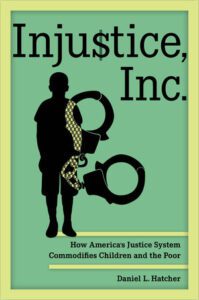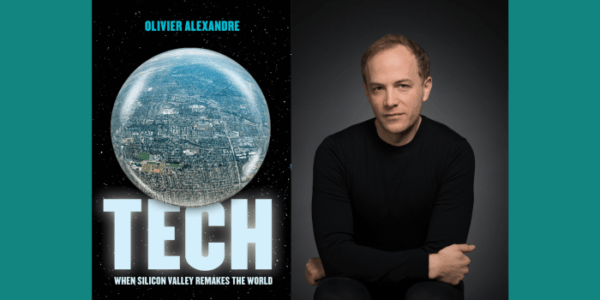By Daniel Hatcher, author of Injustice, Inc.: How America’s Justice System Commodifies Children and the Poor
I’ve been an advocate for impoverished children and adults for over twenty-five years. In my first legal aid job, I represented hundreds of children pulled into the chaotically dysfunctional Baltimore foster care system. I still see their faces. I still wonder if there is more that I could have done.
In my new book, Injustice, Inc., I describe my first day in juvenile court:
After walking with a fleeting feeling of grandeur through the imposing entrance of granite and marble, towering columns, and carved lions, I abruptly encountered a line of mostly Black children shackled in chains as they were shuffled to delinquency proceedings. And then I descended into a small, dank room with flickering florescent light encased in broken yellow plastic over stained flooring, crowded with worn metal tables and mismatched office chairs with torn vinyl—the “stip” room.
The court directed all the attorneys for the children, parents, and the foster care agency to this room, along with the social workers, to reach “stipulated agreements” that would be presented the same day to judicial masters to avoid the time needed for actual court hearings. . .
The room smelled of jaded apathy, packed with bodies sluggishly struggling over access to the chairs or a few inches of wall space on which to lean. A handful of outdated DOS-based computer terminals were surrounded by the attorneys haggling over agreements while typing out sparse summaries of the lives of children with blinking cursors over green text. . . Then, one of the judicial masters sent a message demanding our immediate presence to quickly dispose of the cases because the Baltimore Orioles game was scheduled to start soon. Priorities.
The routine replayed itself, as I would also scramble to find times and locations to meet with my child clients. . . sometimes left with no option but to meet with the children on benches in the chaotic courthouse halls. As I sat next to child-clients on oak benches warn by decades of grasping fear of those who sat before us, I did not feel the presence of justice.
I have also represented almost countless adults, first as a legal aid lawyer and then as a clinical law professor—teaching students while helping clients with their unending poverty-related legal challenges. Each case is a story of human struggle that will not depart my mind.
Inspired by the perseverance and determination of my clients, my own research strives to uncover structural failings within our justice systems that undermine equal and impartial justice. And what I found over and over again was how the systems commodify vulnerable populations to prioritize revenue and profit over justice.
My research revealed a barrage of revenue schemes that were often buried within contract and budget documents. Our foundational courts, prosecutors, probation departments, police and sheriff’s offices, and detention and treatment facilities are all contractually collaborating with each other and with public welfare agencies—using vulnerable populations to generate revenue rather than ensuring their justice and welfare. The moneyed operations are varied in structure but similar in unethical and unconstitutional mechanics, churning in symbiotic relationships: “In a vicious, racialized, industrialized, and monetized cycle, harm fuels and feeds from harm.”
Harm arises when institutions of justice try to run like a business, swapping the ethical pursuit of justice with the mission to maximize money.
Daniel Hatcher
As just one example, some juvenile courts have entered contractual deals to simultaneously act as foster care agencies in order to monetize harm from delinquency proceedings. After ruling that children are delinquent, the courts use their agency role to place children outside of their homes, and then the courts act like courts again to review their own agency actions to claim federal foster care revenue. The more children the courts adjudicate as delinquent and remove from their homes, the more revenue the courts get.
Harm arises when institutions of justice try to run like a business, swapping the ethical pursuit of justice with the mission to maximize money.
Witnessing the extent of this harm can be demoralizing and cause many of us to ask, how can we move forward? But as I explain in the conclusion of Injustice, Inc., I do not write the book with hopelessness:
I have my moments, more than I would like to admit, when I crave the numbing peace of apathy. But when I read numbers, the numbers of children and impoverished adults processed by our justice systems into byzantine contractual revenue schemes, numbers reflecting how the factory-like operations are fueled by over 400 years of racial and economic inequality, numbers uncovering the extent to which our systems of justice have turned toward unconstitutional and humanly destructive moneyed pursuits, I know that apathy is not an option.
Although Injustice, Inc. does not seek to demonize individual justice officials, the book holds all of us in the justice systems accountable, including myself, as attorneys are considered officers of the court. Our institutions of justice are not built of marble or brick but of people within. And the words ‘Equal Justice under Law’ carved over the pillars of the Supreme Court building only have meaning if we give them meaning. When we encounter systemic threats to the ideals of equal justice, we are not absolved by only trying to ensure our individual actions are pure—when the system around us is not. Thus, with Injustice Inc., I seek to expose such structural failings with clear evidence and legal analysis, so we can strive to improve them.
Awareness. Pursuit of the illusive ideal of equal justice doesn’t end. It can’t end. And the effort necessitates awareness. Otherwise, as James Baldwin forewarned in No Name in the Street, “ignorance, allied with power, is the most ferocious enemy justice can have.”




